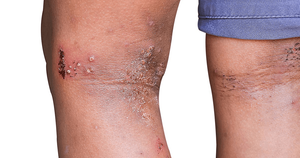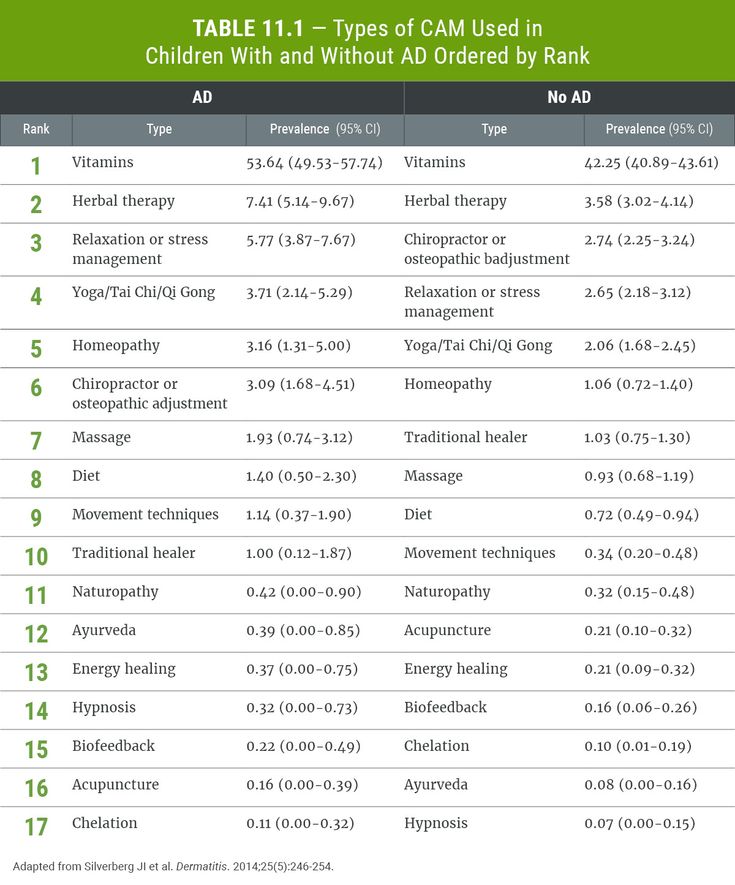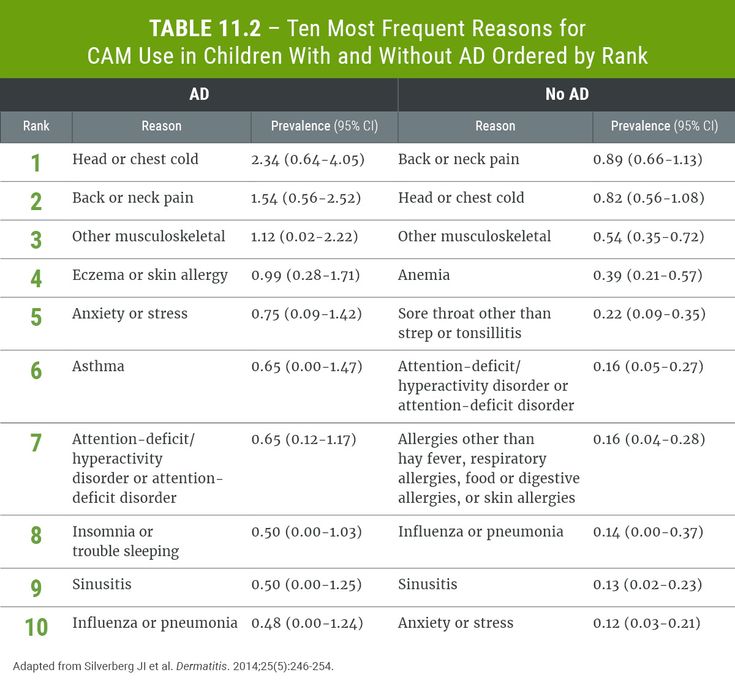Complementary and Alternative Medicine
Introduction
Many patients seek complementary and alternative medicines (CAMs) to help relieve disease symptoms, or as a misguided attempt to cure their condition. According to data from the 2007 National Health Interview Survey (NHIS), of 9,417 US children aged 0 to 17 years, 46.9% used one or more CAM, of which 0.99% used CAM specifically to treat their Atopic Dermatitis (AD). The most common CAMs used in children both with and without AD are shown in Table 11-1. Although certain CAMs have been reported to show some efficacy in the treatment of AD, such studies are few in number and many suffer from substantial design inconsistency that precludes meta-analysis. Studies of CAMs are also often at considerable risk of bias, particularly in terms of blinding of participants and personnel. At this time, systematic reviews have failed to find sufficient evidence to support the use of most CAMs for AD management. The latest AAD recommendations fail to support a number of CAMs, primarily due…
To continue reading
Log in or register to continue reading. It's free!
OR
By signing up to create an account, I accept Healio's Terms of Use and Privacy Policy.
Introduction
Many patients seek complementary and alternative medicines (CAMs) to help relieve disease symptoms, or as a misguided attempt to cure their condition. According to data from the 2007 National Health Interview Survey (NHIS), of 9,417 US children aged 0 to 17 years, 46.9% used one or more CAM, of which 0.99% used CAM specifically to treat their Atopic Dermatitis (AD). The most common CAMs used in children both with and without AD are shown in Table 11-1. Although certain CAMs have been reported to show some efficacy in the treatment of AD, such studies are few in number and many suffer from substantial design inconsistency that precludes meta-analysis. Studies of CAMs are also often at considerable risk of bias, particularly in terms of blinding of participants and personnel. At this time, systematic reviews have failed to find sufficient evidence to support the use of most CAMs for AD management. The latest AAD recommendations fail to support a number of CAMs, primarily due to lack of evidence, including Chinese herbal medicine, acupuncture, massage therapy, aromatherapy, homeopathy, naturopathy, acupressure and autologous blood injections. This module will review the efficacy and safety of selected CAMs in the treatment of AD.
CAM and Childhood AD
The 2007 NHIS study found that CAM use was significantly higher with older age (P=0.004), in Whites and Asians compared with African Americans and multiracial/other (51.1% and 48.0% vs 36.7% and 35.4%, respectively), non-Hispanics compared with Hispanics (49.9% vs 35.6%), those with household income ≥$50,000 vs $0 to $49,000 (55.7% vs 37.9%, P <0.0001), after high school vs lower than high school education (44.9% vs 24.1%, P <0.0001) and those with ≥1 health care interaction in the past year compared to those without (49.3% vs 31.4%, P <0.0001).
Children with AD used CAM for any indication more commonly than children without AD (58.4% vs 45.8%). The most common reasons for CAM use in children with and without AD are presented in Table 11-2. The three most common reasons in both groups of children were head or chest cold, back or neck pain and other musculoskeletal complaints. However, most children used CAM for overall health and not to treat a specific disorder (11.3% vs 5.2%). Several CAMs were specifically used to treat AD, including herbal therapy (0.04% of all US children and 0.46% of US children with AD), vitamins (0.03% and 0.33%), Ayurveda (0.03% and 0.28%), naturopathy (0.02% and 0.24%), homeopathy (0.02% and 0.20%) and traditional healing (0.01% and 0.12%).
Herbal therapy use and vitamin therapy were associated with higher odds of AD (adjusted odds ratio [95% CI] of 2.07 [1.40-3.06] and 1.45 [1.21-1.74], respectively). Children with AD were more likely to use supplementation with multivitamins (1.40 [1.15-1.69]), calcium (2.44 [1.21-4.91]), vitamin B complex (3.67 [1.44-9.33]), vitamin D (4.56 [1.58-13.14]), but not iron, or vitamins C or E. AD prevalence was also associated with use of homeopathic therapy (2.94 [1.43-6.00]), movement techniques (3.66 [1.62-8.30]) and diet (2.24 [1.10-4.58]), particularly vegan diet (2.53 [1.17-5.51]). There were marginal associations of AD prevalence with hypnosis (5.93 [1.00-35.17]) and massage therapy (2.00 [0.99-4.06]) but not acupuncture, Ayurveda, biofeedback, chelation, chiropractic or osteopathic, energy healing, naturopathy, or traditional healing. Although these results suggest an association between increased CAM use and AD prevalence, the cross-sectional nature of the study did not permit determination of the direction of such associations. It may be that some commonly used CAM might contribute toward AD. Alternatively, children with AD may simply be more inclined to use CAM for comorbid disorders and overall health.
Active Natural Ingredients
Chinese Herbal Medicine (CHM)
CHM has been increasingly used for AD and has also been the most extensively studied CAM. CHM appeared promising when introduced in Western literature more than 2 decades ago, and some studies demonstrated benefits of adding CHM to traditional AD therapy. However, as a whole, the efficacy results from studies of CHM taken orally are conflicting, and reports of serious hepatotoxicity have raised concerns about their safety. Certain herbal creams have also been found to be contaminated with topical corticosteroids, raising questions about the authenticity of claims surrounding these products. Despite the uncertainty surrounding the efficacy and safety of CHM, patients continue to seek these agents as a therapeutic option for AD. Current studies are focusing on individual components of CHM as possible AD therapies. However, the best combinations and their long-term safety profiles have yet to be determined.
Two Cochrane reviews, published in 2004 in 2015, assessed the efficacy of CHM in AD. In the 2015 Cochrane review, 28 studies enrolling 2,306 patients were included. Most of the studies were categorized as being at high risk of bias, and there was substantial inconsistency between trials. Four studies that were previously included in their 2004 review were removed since the CHM product they investigated was removed from the market. In both the 2004 and 2015 systematic reviews, insufficient evidence was available to recommend oral or topically applied CHM. Additional, well-designed randomized clinical trials are required to properly evaluate the efficacy and safety of CHM in the management of AD.
Coconut Oil
Coconuts contain several ingredients with potential benefits to the skin, hair and nails. Virgin coconut oil (VCO) is rich in vitamin E, medium-chain fatty acids and a variety of other fats. Recent studies demonstrated clinical benefit of topical VCO for xerosis and AD. A Philippine study evaluated the efficacy of VCO vs mineral oil in 117 patients with mild-to-moderate AD. Treatment with VCO resulted in a decrease in scoring of atopic dermatitis (SCORAD) (68.23% vs 38.13%), higher proportion of moderate (47% vs 34%) and excellent (46% vs 19%) improvement and reduced transepidermal water loss compared with mineral oil.
VCO has also been investigated for its effect on Staphylococcus aureus colonization in AD patients. In a study of 26 patients, colonization decreased from 20 patients at baseline to one in the VCO group (5%) after 4 weeks of treatment. In contrast, treatment with virgin olive oil resulted in a decrease in colonization from 12 patients at baseline to 6 at week 4 (50%). This study suggests that VCO may be effective at helping prevent S aureus colonization.
Colloidal Oatmeal
Colloidal oatmeal has long been used as a skin protectant, with benefits being reported for children with AD as early as 1959. More recently, oat (Avena sativa) use has been refined, with extracts being identified that produce benefits in AD, including as steroid-sparing agents. Patients often report benefiting from colloidal oatmeal creams and enjoying their texture. In clinical trials, Avena sativa has had benefits in a wide age group on eczema severity scores and quality of life measures.
Sunflower Oil
Sunflower oil has been shown to have a beneficial effect on the skin barrier of adult patients with AD, with demonstrated superiority to olive oil, the latter of which may have some detrimental effects. Preliminary studies suggest that proactive application of emollients to infants at risk for AD, beginning as neonates, can reduce AD development and/or severity. One international study assessed early daily emollient therapy for prevention of AD in infants with genetic predispositions to AD, and it included sunflower oil as one of the emollient regimens. Compared to the no-emollient group, a statistically significant protective effect was found with the use of daily emollient on the cumulative incidence of AD (50% relative risk reduction; P=0.017). In addition, no emollient-related adverse events were reported. Another study found that when sunflower oil oleodistillate cream was added to a regimen of topical steroids for AD, it had benefits on dermatoscopic features of the skin, Children’s Dermatology Life Quality Index and Eczema Area and Severity Index scores, and Investigator’s Global Assessment. A steroid-sparing effect was observed in another clinical trial employing twice daily application of a cream containing a sunflower oleodistillate.
Mustard Oil
Mustard oil is not recommended in the treatment of AD, as available data indicates that it aggravates pruritus by inducing the release of substance P in the skin, which causes itching, burning and pain.
Glycerin
Glycerin is derived synthetically or naturally from animal and vegetable triglycerides. Glycerin-based emollients enhance stratum corneum hydration and have been shown to improve xerosis in patients with and without AD. As such, they are often added to products intended for patients with AD. Glycerols can also reduce IL-4 expression, which may improve AD by affecting the Th2 pathway. This is hypothesized to occur via reduced stimulation of B-cell production of immunoglobulin E (IgE).
Dietary Supplements
A 2015 Cochrane systematic review evaluated dietary supplements for treating established AD. Eleven studies were included enrolling a total of 596 patients. The following dietary supplements were assessed in the clinical trials: fish oil, olive oil, corn oil, zinc sulphate, selenium, vitamin E, vitamin D, pyridoxine, sea buckthorn seed oil, buckthorn pulp oil, hempseed oil, sunflower oil and docosahexaenoic acid (DHA). Although the studies with fish oil suggested a possible modest benefit in the treatment of AD, the systematic review concluded that larger studies and more rigorous protocols are required before it can be recommended. Although the public perception is that most dietary supplements are harmless, serious medical complications have been reported with CAM use. Additionally, the out-of-pocket costs of supplements can add up over time. Therefore, their consumption is not recommended until larger, more rigorous trials support their efficacy and safety in AD.
Vitamin D
A 2016 systematic review and meta-analysis of seven observational studies and four clinical trials investigated the efficacy of vitamin D in the treatment in AD. The observational studies were analyzed to determine whether serum 25-hydroxyvitamin D levels were lower in AD patients compared to healthy controls, and the four randomized trials were analyzed to determine whether vitamin D supplementation was effective in the treatment for AD, as assessed by SCORAD index and Eczema Area and Severity Index (EASI) score. The observational studies included 906 AD patients and 657 healthy controls. Compared to the control group, AD patients had lower mean serum 25(OH)D levels (standardized mean difference = -2.03 ng/mL; 95% CI, -2.98 to -1.08). In subgroup analysis, the difference was significant in pediatric AD patients (standardized mean difference = -3.03 ng/mL, 95% CI, -4.76 to -1.29) but not in the adult AD group.
The four randomized, double-blind, placebo-controlled studies enrolled 194 patients, with 104 and 90 treated with vitamin D and placebo, respectively. Efficacy was assessed by SCORAD indexes in two studies and EASI score in the remaining two. Meta-analysis of the four trials demonstrated that SCORAD index (mean difference = -7.43, 95% CI, -9.70 to -5.16) and EASI score (mean difference = -3.14, 95% CI, -6.12 to -0.15) were both lower in the vitamin D supplement group. Treatment with vitamin D also appeared to be of minimal risk, since no major adverse events were reported in these trials.
Probiotics and Prebiotics
Probiotic supplementation, the introduction of live bacteria into the gut, has been studied as both a protective and therapeutic measure in AD. The mechanism for prevention relates back to the hygiene hypothesis, whereby early exposure to gut microbes is hypothesized to upregulate Th-1 cytokine production or steer the immune system away a from a skewed Th-2 response. Meta-analyses of placebo-controlled trials demonstrated that maternal use of probiotics during pregnancy and/or infancy was associated with lower rates of AD in the children. However, there was insufficient evidence for the use of probiotic supplementation in the treatment of existing AD.
Prebiotic supplementation is the provision of nourishment directed at facilitating the proliferation of biologically desirable gut microflora. Two studies demonstrated that prebiotic oligosaccharide supplementation during infancy had prophylactic benefits against developed AD, possibly through the promotion of bacterial growth or immunomodulatory effects.
Bleach Baths
Dilute bleach baths (sodium hypochlorite; ~0.5 cups per full bath [40 gallons of water]) may be recommended as part of maintenance therapy in certain patients, especially those with recurrent skin infections, as they have been shown to reduce the severity of AD. However, despite being recommended in clinical practice guidelines, there is conflicting evidence regarding their efficacy. A systematic review assessed whether bleach baths are consistently effective in improving the severity of AD. The study found that water baths were as effective as bleach baths in a pooled analysis of five studies at week 4, with no differences in S aureus density between treatment groups. In agreement with these results, one study of the bactericidal properties of bleach found that the concentration commonly used in bleach baths (0.005%) had no effect on S aureus survival when applied in vitro (directly on culture plates). In these experiments, diluted bleach solutions only showed bactericidal effects at concentrations also toxic to human cells (0.03% and higher), thus precluding clinical application. Collectively, these results indicate that much of the efficacy of bleach baths in reducing AD severity is attributable to bathing rather than the addition of bleach.
Safety Considerations
CAMs encompass a large and varied group of alternative treatments. Although little data is available regarding the safety profile of most CAMs, serious CAM-related adverse events appear to be rare for those that have been studied. For example, the maximum risk of a serious harmful incident has been estimated to be 1 in 76,000 for patients treated with acupuncture. Homeopathic products, which are highly diluted, also appear to present minimal risk when utilized as directed. In a prospective survey of 50,276 cervical manipulations, most commonly performed by chiropractors, no serious harmful incidents were reported. As such, data suggests that the risks of CAM can be categorized as “very low.” However, overly positive safety profiles of certain CAMs likely reflect their lack of conceivable mechanisms of action (e.g., homeopathy, energy healing).
Underreporting of adverse events is also likely with CAMs. Up to 90% of patients regard CAMs as being entirely safe and may not even consider that such treatments can result in an adverse event. As such, patients may be less likely to report harmful incidents. The adverse events that do get reported with CAMs are likely to be severe. For example, a study on CAM use in Singapore found that of 627 adverse event reports associated with CAM use submitted to the Health Sciences Authority between 1998 to 2009, 80.2% were found to be serious. Between 2009 and 2014, 842 adverse event reports associated with CAM use were reported, with 9.0% involving hepatotoxicity. These data suggest that more mild reactions go unreported. Another factor affecting reporting of adverse events is that CAM practice is most often provided outside of the healthcare system by non-regulated personnel, so even if the patient wanted to report an adverse event, a reporting system may not be available to them.
The simultaneous use of CAMs and conventional drugs may have unforeseen interactions. This is more likely to occur with medicinal CAM products, such as CHM, as these treatments are pharmacologically complex and are likely to have multiple physiological effects. However, the biological effects of many CAMs have yet to be determined, therefore potential interactions with conventional medicines remain largely unknown.
Conclusions
In summary, there is insufficient evidence to support the use of most CAMs for the management of AD. In fact, some may do more harm than good. Patients should be cautioned against the use of CAMs until more data are available regarding their safety and efficacy profiles. Although some CAMs do show promising initial findings, especially natural topical oils and vitamin D, additional large scale randomized clinical trials are required to solidify whether they are more effective than standard of care.
This article was last updated: October 26, 2022
References
- Silverberg JI. Clinical Management of Atopic Dermatitis. 2nd ed. Professional Communications Inc. 2022
- Amestejani M, Salehi BS, Vasigh M, et al. Vitamin D supplementation in the treatment of atopic dermatitis: a clinical trial study. J Drugs Dermatol. 2012;11(3):327-330.




